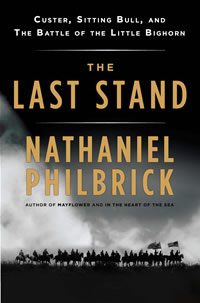Standoff
Nathaniel Philbrick reconsiders Custer, Sitting Bull, and the Battle of the Little Bighorn
An upstart nation was celebrating its centennial in July 1876 and in a bully mood when U.S. President Ulysses S. Grant got word of the unthinkable: a crushing defeat in the West. General George Armstrong Custer’s Seventh Cavalry command had just been wiped out at a battle beside the Little Bighorn River in the Montana territory. Custer, the dashing celebrity of the Indian Wars, had failed. The blame-casting, justifications, excuses, and myth-building began immediately and continued for a century.
In The Last Stand: Custer, Sitting Bull, and the Battle of the Little Bighorn, Nathaniel Philbrick sifts through a great mass of polemics and slanted history with an impressive eye for detail, a solid grasp of the larger picture, and lots of hindsight. He has also dug out hitherto undiscovered sources, including a contemporary account by Private Peter Thompson, who, unlike most writers, apparently had no axe to grind. Philbrick’s four years of exhaustive research included many visits to the battle site and interviews with people, on both the Native American and Federal side, who remember stories told by participants. He’s produced a well-constructed, transparent narrative, a model for how military history should be done. While there are many players in this narrative, Philbrick’s descriptions and portrait captions help a reader keep track of the names. Excellent, well-placed maps show combatant movements. Philbrick also provides 141 pages of notes, bibliography, credits, and index.
 Personalities stand out. Custer, of course, is larger than life. Born for battle, he was sometimes an effective commander and negotiator. But he was also erratic, impulsive, and driven by ego, status, image, and valor. He took his staghounds, brothers, and personal thoroughbred horses with him on campaigns. In public a dedicated husband, he saw no inconsistency in participating in the spoils of war, according to Philbrick: “There was a saying among the soldiers of the western frontier, a saying Custer and his officers could heartily endorse: ‘Indian women rape easy.'” A teetotaler and a dandy, he wore buckskin suits even though cotton was more comfortable. He was fastidious with his famous golden curls and a compulsive tooth brusher. (No detail escapes Philbrick’s microscope.)
Personalities stand out. Custer, of course, is larger than life. Born for battle, he was sometimes an effective commander and negotiator. But he was also erratic, impulsive, and driven by ego, status, image, and valor. He took his staghounds, brothers, and personal thoroughbred horses with him on campaigns. In public a dedicated husband, he saw no inconsistency in participating in the spoils of war, according to Philbrick: “There was a saying among the soldiers of the western frontier, a saying Custer and his officers could heartily endorse: ‘Indian women rape easy.'” A teetotaler and a dandy, he wore buckskin suits even though cotton was more comfortable. He was fastidious with his famous golden curls and a compulsive tooth brusher. (No detail escapes Philbrick’s microscope.)
Perhaps unsurprisingly, given this character description, relations between Custer and the other officers were chronically strained by epic resentments, jealousies, and back-biting. It’s a marvel the command functioned. Custer’s dispatches undermined and blamed everybody, sometimes justly. Major Reno, Custer’s second in command, was unreliable in battle and a drunk. Captain Benteen was roundly disliked, by his own admission, and dawdled instead of rushing to Custer’s support as ordered. General Terry, Custer’s commander and his opposite in temperament and experience, was an administrator who developed the campaign strategy and left Custer, the battle lover, to implement it.
 Sitting Bull was a decade older than Custer and had proven himself a brave warrior. He was able by charisma and reputation to gather and lead a complex assortment of Cheyenne and Lakota bands. Sitting Bull’s alliance was a tenuous federation, however, that demanded continual negotiation and spiritual ceremonies to maintain. That he managed to gather a village of roughly 8,000, including warriors and a huge herd of horses, on the banks of the Little Bighorn in June 1876 was a considerable feat which Custer had not expected. For that matter, nobody knew what to expect: the poor reconnaissance and communications, relying completely on scouts on horseback, made true planning impossible. General Terry can hardly be blamed for a failed strategy, based as it was on faulty input.
Sitting Bull was a decade older than Custer and had proven himself a brave warrior. He was able by charisma and reputation to gather and lead a complex assortment of Cheyenne and Lakota bands. Sitting Bull’s alliance was a tenuous federation, however, that demanded continual negotiation and spiritual ceremonies to maintain. That he managed to gather a village of roughly 8,000, including warriors and a huge herd of horses, on the banks of the Little Bighorn in June 1876 was a considerable feat which Custer had not expected. For that matter, nobody knew what to expect: the poor reconnaissance and communications, relying completely on scouts on horseback, made true planning impossible. General Terry can hardly be blamed for a failed strategy, based as it was on faulty input.
Philbrick’s wide-angle lens points out how myths and ironies grew in the following decades. Sitting Bull’s federation was itself a kind of last stand. Within a few years, all the major tribal leaders had moved to reservations, where they could be watched and kept dependent. The basis of their former economy, the free ranging bison herds, was fast disappearing in any case. Even Sitting Bull eventually retired to the reservation, where he was shot, supposedly resisting arrest for subversion, in 1890. Two months later, the final atrocity at Wounded Knee effectively finished the conquest.
As for Custer, his body was found a few days after the slaughter, mutilated but reportedly with a smile on his face. Nobody will ever know for sure if he had displayed personal bravery in his last stand, but the truth didn’t matter to the popular imagination, for whom Manifest Destiny hardly stopped at the shores of the Pacific. “Just as Custer had stood fearlessly before overwhelming odds, the United States must stand firm against the likes of Spain, Germany, and Russia,” Philbrick notes. “Now that America had completed its bloodstained march across the West, it was time to take on the world.”
Nathaniel Philbrick will sign copies of The Last Stand at Davis-Kidd Booksellers in Memphis on May 20 at 6 p.m.


